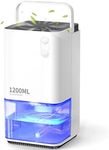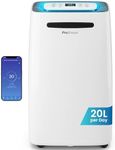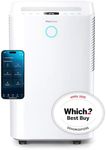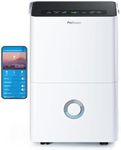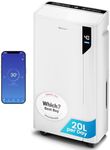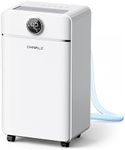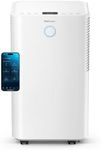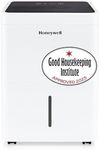Buying Guide for the Best Dehumidifier
Choosing the right dehumidifier is essential for maintaining a comfortable and healthy indoor environment. Dehumidifiers help reduce humidity levels, preventing mold growth and improving air quality. When selecting a dehumidifier, consider the size of the space you need to dehumidify, the level of humidity, and any specific features that might be beneficial for your situation. Understanding the key specifications will help you make an informed decision that best suits your needs.CapacityCapacity refers to the amount of moisture a dehumidifier can remove from the air in a 24-hour period, usually measured in pints or liters. This is important because it determines how effective the dehumidifier will be in your space. Small capacity units (20-30 pints) are suitable for small rooms or areas with mild humidity. Medium capacity units (30-50 pints) work well for medium-sized rooms or moderate humidity levels. Large capacity units (50+ pints) are ideal for large spaces or areas with high humidity. Choose a capacity based on the size of the area and the severity of the humidity problem.
Coverage AreaCoverage area indicates the maximum size of the room or space that the dehumidifier can effectively handle, usually measured in square feet or square meters. This is crucial because using a dehumidifier that is too small for your space will be inefficient, while one that is too large may consume unnecessary energy. For small rooms, look for a dehumidifier with a coverage area of up to 300 square feet. For medium rooms, aim for 300-700 square feet. For large spaces, consider models that cover over 700 square feet. Match the coverage area to the size of your room for optimal performance.
Energy EfficiencyEnergy efficiency refers to how much energy the dehumidifier uses to remove moisture from the air. This is important for keeping your energy bills low and reducing environmental impact. Look for models with an Energy Star rating, which indicates they meet energy efficiency guidelines. More efficient models will use less electricity to achieve the same results, making them more cost-effective in the long run. Consider your usage patterns and choose a model that balances performance with energy consumption.
Noise LevelNoise level is the amount of sound the dehumidifier produces while operating, usually measured in decibels (dB). This is important if you plan to use the dehumidifier in a living space or bedroom where noise could be disruptive. Dehumidifiers with noise levels below 50 dB are considered quiet and suitable for bedrooms or living rooms. Models with noise levels between 50-60 dB are moderate and may be acceptable for less noise-sensitive areas. If noise is a concern, look for models specifically designed to operate quietly.
Drainage OptionsDrainage options refer to how the dehumidifier disposes of the collected water. This is important for convenience and maintenance. Some models have a removable water tank that needs to be manually emptied, which is suitable for occasional use or smaller units. Others offer continuous drainage options, where a hose can be attached to direct water to a drain, ideal for continuous or heavy use. Consider how often you want to empty the tank and whether you have access to a suitable drainage point when choosing a model.
Additional FeaturesAdditional features can enhance the functionality and convenience of a dehumidifier. These may include a built-in humidistat to automatically maintain desired humidity levels, a timer for scheduling operation, or a filter to improve air quality. Some models also offer smart connectivity, allowing you to control the unit via a smartphone app. Consider which features are important to you based on your lifestyle and specific needs. For example, if you want to maintain a specific humidity level without constant adjustments, a model with a humidistat would be beneficial.

